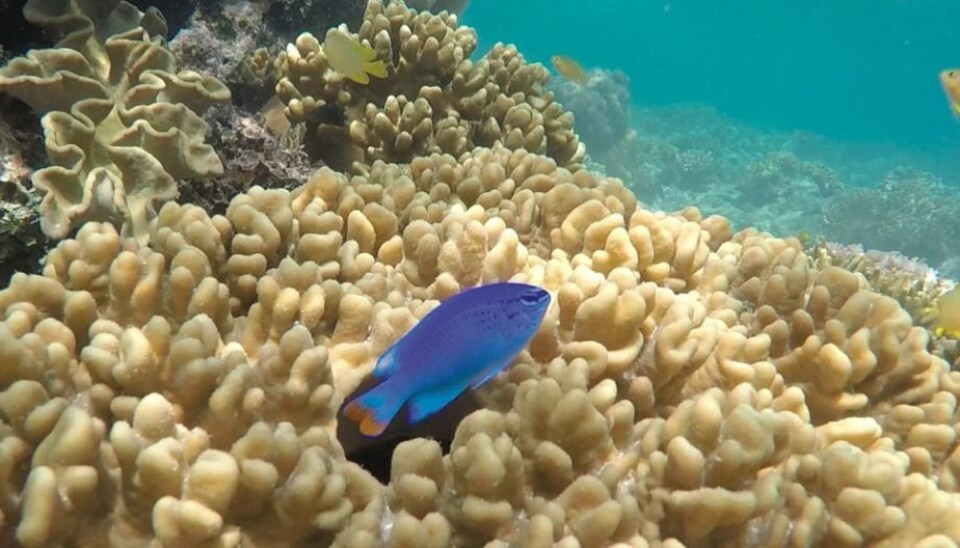
Female fish lose interest in colourful males
Norwgian researchers made a surprising discovery when they followed the mating habits of damselfish on the Great Barrier Reef.
The researchers were taken back when they found female fish changing their preferences in male looks in the course of a mating season.
“We weren’t surprised in the beginning of the season when the females preferred the flashiest coloured males to start with. The strange thing was at the end of the mating season the females were showing a preference for the duller–looking guys.”
“It became the least colourful males who had the best luck with the ladies,” says Sebastian Wacker. He was one of the biologists on this project and the first author of an article in the latest edition of the journal Behavioral Ecology.
The object of the study was a species of damselfish, Chrysiptera cyanea, which has several common names, including “Blue Devil”.
Masks and snorkels
The life of the small damselfish living in the astounding coral reefs of tropical seas might appear idyllic.
But besides constantly avoiding being eaten by something further up the food chain, the struggle among males to be attractive to the opposite sex and ensure the propagation of their genes is as tough here as elsewhere in the wilds.
One of the hard facts of life for male damselfish of the species Chrysiptera cyanea who hope to fertilize the eggs of a female is to impressively display aggression toward rival males.
This can get devilishly rough.
The researchers from Trondheim spent hours off the east coast of Australia snorkelling and taking notes on their observations of the mating habits of these little Blue Devils.
By first observing them in laboratory aquariums and then in their natural environment for an entire mating season the scientists discovered a surprising change in the female damselfish behaviour towards the males.
A male Blue Devil lives in a hole beneath the coral. He tries to entice a female into his bachelor digs. She is just slightly interested. If he can get her inside his tiny cave she could lay several hundred eggs there. (Film: Sebastian Wacker).
Sexual selection
What actually convinces animals to prefer one partner to another?
That depends a lot, but the choices they make are called sexual selection.
Biologists who study animal sexual behaviour observe some weird stuff. But one general attribute among animals tends to be the opposite of our human culture: Males are more decorative and colourful than females.
The guys who do the most for the ladies, one way or another, are usually those who pass on their genes.
Unexpected
The scientists from NTNU had not expected any changes of preferences in the course of the mating season.
Corresponding studies have not shown any such revisions. But the NTNU researchers had an opportunity to spend more time making observations of these fish in the area than others before them.
“This goes to show that research of phenomena in nature ought to continue over longer periods,” says Sebastian Wacker.
The scientists studied the natural reproduction season of the aquarium fish first. They repeated this with two males and one female as participants, 30 times, using new individuals each time.
While that was going on, they donned snorkelling gear equipment and swam round on an Australian coral reef, making sure that the behaviour they saw in the lab corresponded with mating practice in the ocean.
Males get tired out?
The biologists from Trondheim discovered that after a while the female fish in the Pacific Ocean off Australia changed their opinions of what comprised a suitable and attractive male.
One conclusion from this thorough study of the sexual activities of damselfish is that females’ notions of what comprises an attractive male can be flexible, a trait they refer to as plasticity of mating preference.
Among Chrysiptera cyanea the flashy-tailed males that are most attractive in certain situations can get lose favour, taking second place to others with alternative attributes.
The biologists from Trondheim are uncertain what causes this change in preference in the course of a mating season.
One ready hypothesis, however, is that the colourful males who dazzle the damsels might simple start to wear themselves out through all their sexual activity in the early season – and the females are aware of this.
There is no gender equality when it comes to damselfish parenthood. The males have to stand guard of the eggs once they are deposited in a nest and fertilised. Perhaps the good-looking guys are rather warn out toward the end of the season and the duller ones, although less kind to the female eye, get selected as heartier defenders of the next generation.
--------------------------------------
Read the Norwegian version of this article at forskning.no
Translated by: Glenn Ostling





